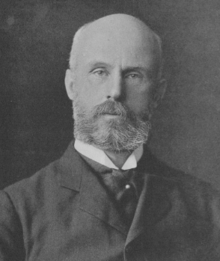William Sturgis Bigelow
William Sturgis Bigelow (born 4. April 1850 in Boston ( USA ), died 6. October 1926 ) was an American physician and collector of Japanese art.
life and work
The early years
William Sturgis Bigelow was born into a prominent Boston medical family. He graduated from Harvard College in 1871 and from Harvard Medical College in 1874. He was then an associate professor at the Medical College and a surgeon at General Hospital Massachusetts.
Japan
Bigelow later gave up medicine and in 1882 accompanied Edward S. Morse on his third trip to Japan. Bigelow felt comfortable in the country and resided in Tōkyō and Nikkō . Bigelow stayed in Japan for seven years and traveled with Morse and Fenollosa, accompanied by Okakura Kakuzō as interpreters, to parts of the country that were forbidden to other foreigners. The group visited the Shōsō-in des Tōdai-ji to see the treasures of Emperor Shōmu . She received some ceramic shards, the only items of the Shōsō-in known to be outside the treasury.
Among the many other items Bigelow collected during his time in Japan were a number of gilded bronze statues of the Hōryū-ji and a mandala from the Hokke-dō of the Tōdai-ji, one of the oldest Japanese paintings to ever leave Japan. Morse collected old ceramics, Bigelow collected armor, and Fenollosa collected paintings, often with Bigelow's financial help. During his time in Japan he supported Okakura in his endeavors to establish a private art academy under the name Nihon Bijutsuin .
Back in the USA
On his return to Boston in 1889, Bigelow devoted much of his time to studying art and Asian religions. He also often invited college friends such as Henry Cabot Lodge , Brooks and Henry Adams, and Theodore Roosevelt , who regularly made Bigelow's home the social hub of Boston. He donated approximately 75,000 objects of Japanese art to the Museum of Fine Arts in Boston. His collection, along with those of Morse and Fenollosa (the latter was paid for by Charles Goddard Weld), Okakura and a few others, formed the basis for the museum's newly established Asian Art Department and the largest collection of Japanese art outside of Japan.
Bigelow was elected a Fellow of the American Academy of Arts and Sciences in 1911 . He became an active trustee of the Museum of Fine Arts and went on to collect paintings. He also advised Isabella Stewart Gardner , the founder of the Isabella Stewart Gardner Museum .
Bigelow had decreed that half of his ashes should be buried in his homeland and the other half at Mii-dera . The grave is located at the Hōmyō-in, a side temple of Mii-dera, next to that of his friend Fenollosa .
Individual evidence
- ↑ Bigelow, William Sturgis (8) = wil82311.htm. Retrieved April 5, 2020 .
- ↑ a b c d Bigelow Society
- ↑ Book of Members 1780 – present, Chapter B. (PDF; 1.2 MB) In: American Academy of Arts and Sciences (amacad.org). Retrieved April 4, 2020 .
literature
- S. Noma (Ed.): Bigelow, William Sturgis . In: Japan. An Illustrated Encyclopedia. Kodansha, 1993, ISBN 4-06-205938-X , p. 108.
Web links
- Bigelow's résumé of the Bigelow Society.
| personal data | |
|---|---|
| SURNAME | Bigelow, William Sturgis |
| BRIEF DESCRIPTION | American doctor and collector of Japanese art |
| DATE OF BIRTH | April 4, 1850 |
| PLACE OF BIRTH | Boston |
| DATE OF DEATH | October 6, 1926 |

